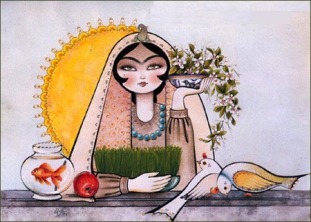Well, the time is fast approaching for Norooz, otherwise known as Persian New Year’s, which begins on the first day of Spring. If you are in London, be prepared to celebrate at 5:48 am, as this is when the New Year’s changes to 1387.
As with most celebrations, Norooz brings out the party mood among all Iranians. Most diasporic Iranians will celebrate Norooz with family and friends at home, and/or paint the town red later on by attending a Norooz Gala party thrown by some diasporic Iranian organization at an expensive hotel/hall, paying an excess of $50-200 for a single ticket. In London, the Iran Heritage Foundation charged between £80-120 for a single ticket. If you convert that into US dollars, that would be between $160-240! With such a steep price for a single ticket, I’d expect a meal as tasty as the food at Behesht with Vigen resurrected from the dead for entertainment!
I utterly detest at how formulaic Norooz parties are in the diaspora. Every Iranian cultural organization rents out the same, tired hotel/hall, hiring some no-name, no-talent band, and forcing us to consume what is a very pale imitation of Persian/Middle Eastern cuisine. I can’t tell you how many Iranian Norooz parties that I have attended where the hotel food was fit for cockroaches. Yet, despite all the complaining, we still attend these uninspired, expensive parties.
I wish all Norooz parties were like the one I experienced as a young girl in Pittsburgh, circa 1988! I don’t know who were the organizers of the first Norooz party in the ‘burgh, but I gather it was a few Iranian families with the help and coordination of a some Iranian students at the University of Pittsburgh. This clever and inspired group rented out the Irish Centre in Squirrel Hill. I vividly remember entering on the day of the festivities and looking up at the stage, realizing that someone had replaced the words “Irish Centre” and the flag of Ireland, with the words “Iran Centre” and a non-political (i.e., nothing in the center) flag of Iran. At least for one day, we diasporic Iranians had a place to call our own!
What a marvelous evening it was– there was delicious Persian food cooked by volunteers, a traditional dance skit done by a group of young ladies that was so popular with the crowd that they were asked to do a repeat performance! Afterwards, the crowd (about 100-200) got to boogie to the beats of mix-taped Iranian pop music via Tehrangeles, California. Back in the ’80s-early ’90s, no Iranian party was complete without music from three popular diasporic artist of that decade: Fataneh, Andy & Korous, and towards the end, Susan Roshan (click on the links to hear those golden oldies). At the time, because Googoosh, Iran’s pop diva, was still living in Iran, many diasporic Iranian female singer tried to copy or create an illusion of the Googoosh legacy. Among these “Googoosh wannabes”, Susan Roshan was the closest in singing and being a trend setter like her predecessor. I remember that Tanin use to sell VHS tapes of their Norooz programing. For every Iranian residing in backwater places where being Iranian was like being an extinct species, no matter how cheesy those Tanin programs where, they provided much Norooz cheer and joy. It was through those Tanin videos that I became acquainted with Susan Roshan and Andy & Korous. I remember for the “Rooh-e-sheytoon” video, Susan was rockin’ a PVC black bondage cat-suit. Tre risque!
Music made during the ’80s reflected the limbo state that many in the nascent Iranian diaspora faced. Prof. Hamid Naficy, has written extensively and is the foremost expert on Iranian diasporic culture, especially focusing on transnational media and music. Naficy wrote in “Popular Culture of Iranian Exiles in Los Angeles” in Irangeles: Iranians in Los Angeles, that
“Exile pop music is often performed at concerts, where thousands of Iranian teenagers and adults bask in the tumult and, sometimes, the nostalgia and allure of the music…By staging indigenous rituals and performances in a foreign country, the exile play their private, ethnic, and national symbolic forms of culture against those of the host society. Moreover, these cultural events not only reduce isolation and loneliness but also promote ethnic solidarity and integration, helping the exiles find new friends, companions, lovers, and especially future spouses.”
Very true, Prof. Naficy– I remember the budding romances that began on the dance floor of the Iran Centre/Irish Centre that night. What was most memorable was the organic essence that evening- nothing was predictable, but everyone seemed happy to be together to celebrate the New Year. When I say “everyone”, I mean Iranians of all backgrounds: doctors, businessmen/women, dentists, engineers, students, refugees, rich, poor, etc. However, this sort of solidarity has ended; now some Iranians can weed out what they consider “undesirable elements” by electing to go to a Norooz party sponsored by a professional body/organization. Iranian physicians can go to an all-physician only Norooz party. The same is true for dentists, engineers and the like. This fragmentation along class and educational backgrounds is probably why Norooz parties are so stale now.
I long to go back to that magical Norooz celebration in 1988. Since fashion is recycling from the ’80s, perhaps this Norooz, I’ll make a play list of all those cheesy 80’s Iranian songs that I learned to speak Farsi from.
From me to all of you: Eid-e shoma Mobarak: Happy Norooz!
Sanaz

